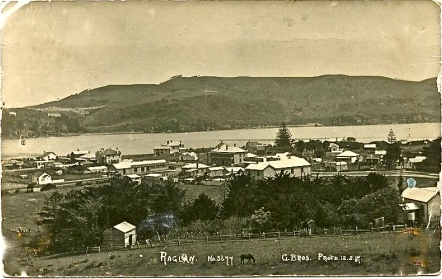
Raglan in 191 7 with harbour and Te Akau hills in the background. Close up view of store signs says GILMOUR BROS MOON CAMERON. A lone car is parked outside the Gilmours Bros store. Photographer: Gilmour Bros. Raglan & District Museum Collection x001.56.12
This postcard from the museum’s collection shows Raglan in 1917. It seems to have been taken from Main Rd (Norrie Ave since 1955), Gilmour St being along the fence in the foreground.
So, starting on the far right of the card, is George Moon’s house (replaced in 2013) of about 1900.
The old Agricultural & Pastoral Association Showground was sold for £31 in 1917 and Bankart St was built there (Walter Bankart was the first President of A&P). Beyond that, just over the bushes, is the 1893 Town Hall, burnt down in 1927 and replaced by the Municipal Buildings in 1929.
Across the road was Frank Bray’s butchery (1911 – 1921).
Above the Town Hall, Moon & Cameron’s store is partly visible. It became a garage about 1918 and was demolished when the supermarket was built.
The 1905 Harbour View Hotel remains today, as does Sydney Dando’s 1902 shop, now The Shack.
Opposite that was Gilmours Store store, burnt down in 1921, rebuilt in 1928 and now Blacksands.
Further along Green St (now Wainui Rd) is the 1877 Anglican Church. Built of kauri held by brass screws, it was one of ten 1874 cottages shipped from Onehunga to encourage immigrants. St Peter’s replaced it in 1925, but it remained the church hall until 1952. It was then used as a school and shop until it became Vinnies in 1989 and is now Valentes. Only a rose window at the back reveals its original use.
Behind the church is 1 Wi Neera St, built in 1893 and remaining in relatively original condition, hence its listing.
On the harbourside beyond is another of the ten cottages. It was Te Uku’s teacher’s house until the present school was built in 1908. Blacksmith, Peter Middlemiss, bought and moved it. It has since had an attic added.
To the right are Smith’s Supply Stores (now Hong Kong Kitchen) and the 1914 Post Office, demolished in 1988.
Across the road from there is the bakery (now The Depot) and, on Cliff St behind that, The Royal Hotel and its stables. It had burnt down in 1905 and was not replaced after a fire in 1931.
Do you know the history of other places in this photo? If so, let us know.
